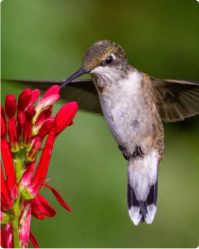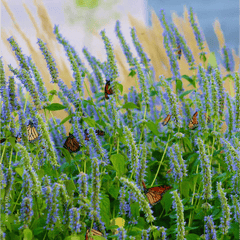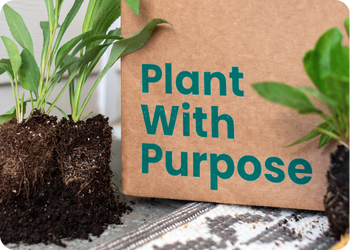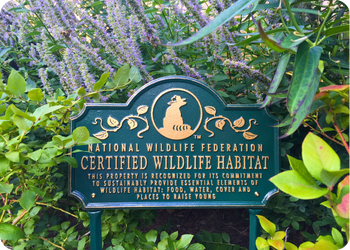Native Plant Landscape Design: How To Create The Wildlife Garden Of Your Dreams

Landscaping with Native Plants: Tips and Tricks for a Thriving Garden
Among the many garden landscape ideas, native plant landscape design stands out as a harmonious approach that not only enhances the aesthetic appeal of your garden but also pledges allegiance to the rhythms of nature. This method of native garden landscaping isn’t a mere trend. It's a growing movement toward creating gardens that are both beautiful and beneficial to the local environment.
In the following sections, we'll explore the ins and outs of landscape gardening with a focus on native plants, offering you insights and tips to cultivate a garden that's in sync with your local ecosystem, replete with ideas to bring your vision to life. Join us as we explore the art of native garden landscaping, where beauty meets sustainability. If it's all too much, don't forget all of our native plant collections come with a suggested design!
Understanding native plant landscaping
In the world of landscape gardening, the term native plants refers to species that have evolved naturally in an area. These are the flora that have co-evolved with local wildlife and are the foundation of their habitats. Native plant landscaping is the practice of designing and maintaining gardens that primarily include these indigenous species.
The ecological advantages of native plant landscape design are substantial. Native plants are pivotal in preserving local genetic diversity and offering support for wildlife. They provide the necessary habitat for numerous pollinators, birds, and insects, which have adapted to coexist with these specific plants. These relationships are crucial for the pollination of crops and the health of local ecosystems.
From a practical standpoint, native garden landscaping is highly beneficial for gardeners. Native plants typically require less water and fewer pesticides than their non-native counterparts. They're generally better adapted to the local climate and soil conditions, which means they're more resistant to disease and drought. This often results in lower maintenance needs and cost savings in terms of water usage and gardening supplies.
Planning your native plant garden
The start of any successful garden begins with a well-thought-out plan, especially when it involves integrating garden landscape ideas with native plants. Begin with understanding which plants naturally thrive in your region. For instance, the sun-loving dense blazing star and the shade-tolerant woodland sunflower are excellent starters for varied light conditions, depending on the state you live in.
Read resources such as our guide to plants and sunlight to learn more about sunlight requirements for your native selections. And for those just starting out, the beginner’s guide to gardening for wildlife with native plants is an invaluable tool to get your garden plan on the right path.
Step 1: Research native species
Before you break ground, research the native plants of your region. Look for native plant garden ideas online, consult local gardening books, or visit botanical gardens and nurseries specializing in indigenous flora to get inspiration. Make a list of species that not only appeal to you visually but also suit your garden's conditions and location in the US.
Step 2: Analyze your garden conditions
Understanding the specifics of your garden's environment is key to successful landscape gardening. Evaluate the soil type, pH level, and drainage capabilities. Assess the patterns of sunlight and shade throughout the day and across seasons. Consider your local climate, including temperature ranges and precipitation patterns. These factors will determine which native plants will thrive in your garden.
Step 3: Design your layout
With knowledge of your garden's conditions and a selection of suitable native plants, begin sketching a layout. Use native plant garden ideas to inspire the arrangement of your space. Consider grouping plants with similar sunlight and water needs together. Plan for succession blooming to ensure a garden that's vibrant throughout the seasons.
Step 4: Prepare the soil
Once you have a design, prepare your garden. Amend the soil if necessary to suit the needs of the native plants you've chosen. Remember that many native plants prefer the local soil without significant alteration, as it mimics their natural habitat.
Step 5: Maintenance plan
Create a maintenance schedule based on the needs of your native garden. Although native plants generally require less upkeep, they still benefit from the occasional pruning and weeding.
By following these steps and considering the unique requirements of your local ecosystem, your native plant garden ideas can take root and grow into a thriving, sustainable landscape. This careful planning ensures your native garden is well-equipped to flourish, offering a slice of nature's bounty right in your own backyard.
Related Reading: What is a Pollinator Garden & How to Plant a Garden for Pollinators
Designing your native plant landscape
Designing a native plant landscape marries aesthetics with ecology, forming an outdoor space that’s both visually pleasing and environmentally responsive. Here’s how to apply native plant landscape design principles to achieve a cohesive and sustainable garden.
Principles of Native Plant Selection and Placement
- Right plant, right place: Select native species that are well-suited to the specific conditions of each part of your garden. Match sun-loving plants with sunny spots and shade-tolerant plants with darker areas.
- Layering: Mimic nature by planting in layers — from tall canopy trees to understory shrubs, followed by herbaceous plants and groundcovers. This creates a dynamic, textured landscape. As you design, consider how options like the obedient plant can provide vertical interest.
- Mass planting: Grouping the same species together in clusters not only makes a visual impact but also attracts more pollinators, creating a healthier ecosystem.
- Seasonal planning: Choose a variety of plants that offer interest across all seasons — flowering in spring, fruiting in summer, foliage color in autumn, and structure in winter.
Related Reading: When to Expect Emergence from Your Native Plants Each Year
Creating Focal Points

Every garden needs a star attraction, and garden landscape ideas that include native plants offer many options:
- Specimen trees or shrubs: Choose a standout native tree or shrub as a central feature. You might choose the winterberry shrub for its striking red berries or the American beautyberry shrub for its captivating purple clusters.
- Sculptural plants: Incorporate plants with striking forms, such as agaves or grasses, to serve as living sculptures.
- Water features: Even a simple bird bath can act as a focal point, drawing wildlife and providing a visual anchor. Always prioritize wildlife-friendly water features.
And if you’re planning on introducing a range of native shrubs to your landscape garden, check out our guide on how to plant native shrubs for wildlife for guidance on using shrubs as foundational plantings.
Designing borders with native plants
- Mixed borders: Combine shrubs, grasses, and perennials to create borders that are alive with activity throughout the year. Consider the height, color, and texture to create depth and interest.
- Themed borders: Create a theme around specific native plant garden ideas, such as a pollinator garden or a rain garden, selecting plants that support these concepts.
Incorporating Mixed Beds
- Habitat beds: Design beds that provide habitat essentials — food, shelter, and nesting sites. Use a mix of plants to cater to a variety of wildlife.
- Succession planting: Arrange plants so that as one finishes blooming, another begins, providing a continuous display of color.
By using these native plant landscape design principles, you can create a garden that is not only a personal refuge but also a vital part of the local ecosystem. Utilize native plant garden ideas to establish a unique and engaging landscape that invites both admiration and nature's diversity.
Related Reading: Guide to Milkweed Plants and Monarch Butterflies
Plant selection for your garden landscape

Selecting the right plants is a cornerstone of any native plant landscape design. Each plant plays a distinct role in your garden ecosystem, contributing to the overall health and aesthetic of your outdoor space. Here's how to select native plants for different areas of your garden, using principles that align with native plant garden ideas.
Trees: The canopy layer
Trees form the backbone of your landscape, providing structure, shade, and shelter. In landscape gardening, they create the canopy layer, offering habitat and food for wildlife. When selecting trees, consider their mature size and root system to ensure they fit within your space without disrupting surrounding areas.
Shrubs: The understory
Shrubs fill the middle layer of your garden, bridging the gap between the tall canopy and the ground. They can offer berries for birds and flowers for pollinators. Choose shrubs of varying heights and blooming periods to maintain year-round interest and support.
Flowers: The colorful accents
Flowering plants add splashes of color and attract a host of pollinators. Incorporate a variety of species that bloom at different times to keep your garden lively throughout the growing season. Consider flowers that offer nectar for butterflies and hummingbirds, as well as those that can serve as host plants for caterpillars.
Grasses and groundcovers: The foundation
Grasses and groundcovers are essential in native plant garden ideas, filling in gaps and providing cover for ground-dwelling creatures. Native grasses can add texture and movement, while groundcovers prevent soil erosion and suppress weeds.
Select plants that will bring life to your garden throughout the year. The great blue lobelia and rough blazing star are perfect for adding late-season color, while the lanceleaf coreopsis can brighten your space earlier in the year. When considering plants for pollinators, think about introducing plants like orange butterfly milkweed.
When planning your native plant landscape design, visit Garden for Wildlife and use our handy ZIP Code native plant finder to find the plants that are best suited for your region. Remember to consider not only the environmental conditions of your garden but also the needs of local wildlife. By carefully selecting a diverse array of native plants, your garden will not only be a personal retreat but also a vital part of the local ecosystem.
Overcoming challenges in native plant landscaping
Embracing native plant landscape design is a rewarding endeavor, but it's not without its challenges. From pesky pests to unpredictable weather and the encroachment of invasive species, there are several hurdles that gardeners may face. However, with a few strategic garden landscape ideas, these issues can be managed or even turned into advantages.
Pest management
Pests can be particularly troublesome in any garden setting. The key to managing pests in a native plant landscape is to foster a balanced ecosystem. Native plants, such as the slender mountain mint, are known for their pest-repellent properties. Their strong scent can naturally deter unwanted insects while also attracting beneficial pollinators to your garden.
- Attract beneficial insects: Integrate plants to attract predatory insects that feed on common pests.
- Diversity is defense: Plant a diverse array of species to prevent pests from decimating your entire garden.
- Go natural: Use organic pest control methods such as neem oil or insecticidal soap, which are less harmful to the environment.
Dealing with climate extremes
Climate extremes, whether it's a scorching drought or a frigid cold snap, can stress your native garden. To counteract the effects of climate extremes, consider robust plants like wild geranium, which can endure a range of conditions from shade to sun, and swamp milkweed, which is well-suited to wetter areas and can tolerate occasional flooding.
- Plant research: Ensure you're planting species that are well-suited to withstand your local climate's extremes.
- Water wisely: Implement water-saving techniques such as drip irrigation to provide a steady supply during droughts without wasting resources.
Combating invasive species
Invasive non-native plants can outcompete your natives and disrupt the local ecosystem. In areas prone to the spread of invasive species, planting robust native ground covers can provide an effective defense.
- Early identification: Learn to identify invasive species early and remove them before they become established.
- Regular monitoring: Keep a regular check on your garden and immediately deal with any invasive plants that appear.
- Plant natives aggressively: Fill in spaces with native plants to minimize the areas available for invasives to take root.

For example, the butterfly bush (buddleia davidii) is not native to North America; it is a species that evolved in Asia where it was first cultivated as an ornamental. Because of this, not a single native caterpillar in North America can feed on butterfly bush. Without host plants to feed their caterpillars, butterflies can’t complete their lifecycle and their populations suffer. Better option? Any species of milkweed, which is the sole host plant for the iconic Monarch butterfly. Whorled milkweed, for example, can occupy the space invasive plants like butterfly bush might otherwise take over, and its attractive flowers will bring additional beauty and ecological benefits to your garden.
Wildlife Challenges
While native gardens attract wildlife, sometimes they can attract a little too much attention. To mitigate these challenges, choose plants that are beautiful to us but less appealing as a food source to animals.
For example, the dense blazing star is a striking plant that tends to be less favored by deer, ensuring your garden remains intact. Similarly, the great blue lobelia, with its vibrant blue flowers, is often bypassed by nibbling fauna while still attracting pollinators like hummingbirds and bees.
Both of these plants offer high visual impact and resilience, making them excellent choices for a garden that aims to be both attractive and wildlife-resistant.
- Strategic planting: Use plants that are less appealing to the wildlife you want to deter, like deer-resistant species.
- Physical barriers: Employ barriers or netting to protect particularly vulnerable plants without detracting from the garden's natural beauty.
Each challenge that native plant landscape design presents an opportunity to grow as a gardener and to evolve your garden landscape ideas. By applying these solutions, you can maintain the health and beauty of your native plant garden, ensuring it remains a thriving part of the local environment.
Embrace native plant landscaping
From the foundational planning stages to the selection of diverse flora that flourishes across seasons, the insights offered here aim to empower you with native plant garden ideas that are both environmentally beneficial and aesthetically pleasing.
Remember, your garden can be a sanctuary for local wildlife, a bastion for native biodiversity, and a personal retreat that resonates with the natural landscape. By choosing native plants, you're not just gardening — you're stewarding the land and contributing to a larger ecological balance.
Now is the perfect time to take the leap and start your own native plant garden. Let your garden landscape ideas come to life and become part of a growing community of wildlife enthusiasts.
To continue your journey, sign up for the Garden for Wildlife newsletter. By subscribing, you'll gain valuable insights, tips, and special offers to enhance your gardening endeavors. Plus, you'll be the first to know when new native plant products become available, ensuring your garden is always at the forefront of native plant landscape design.


Find Native Plants by Zip Code
We took the guesswork out of planting native. Check your zip to see what ships!




















